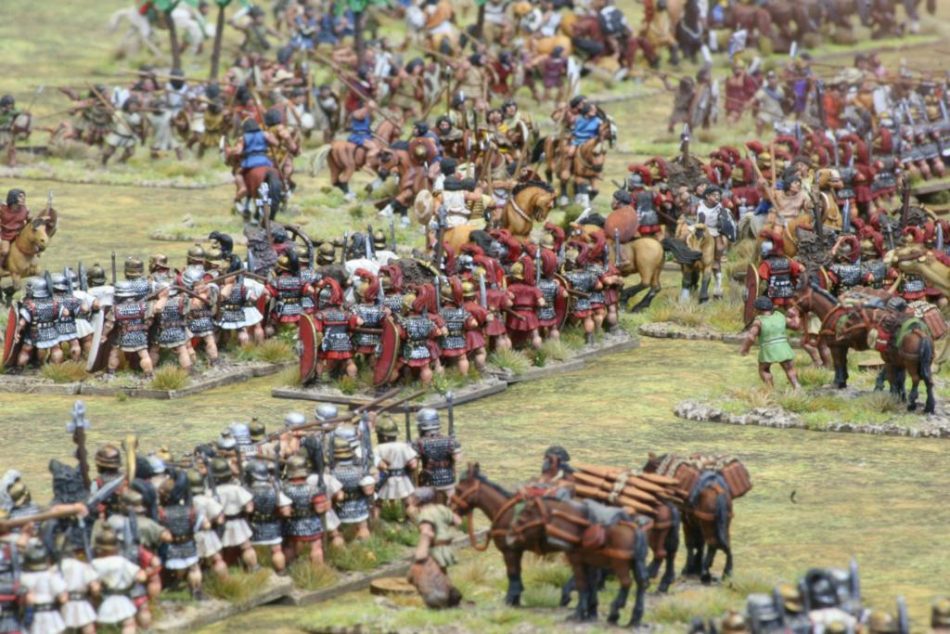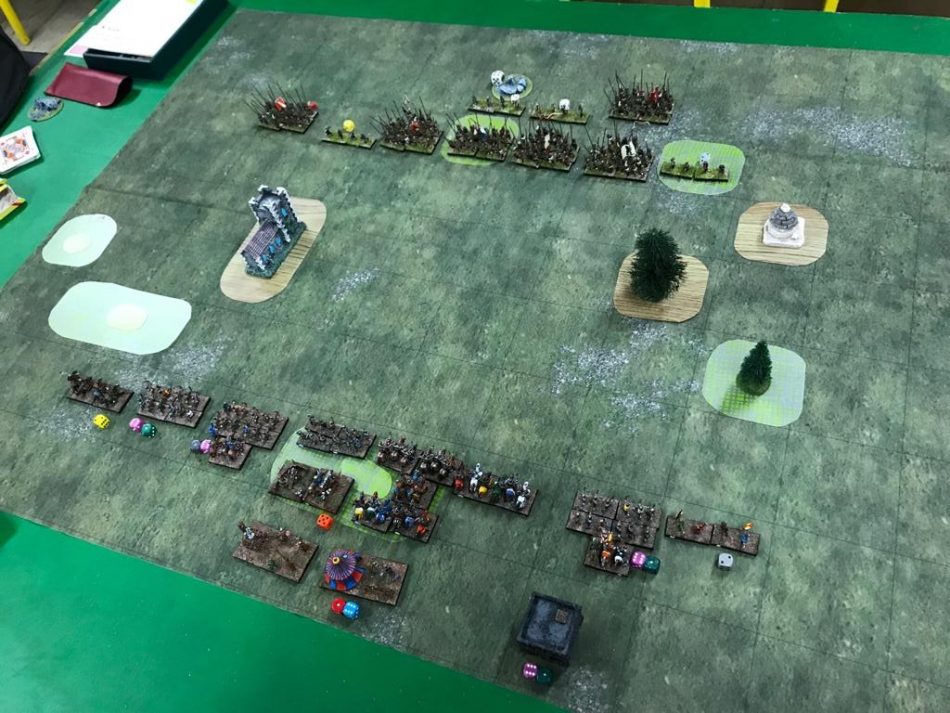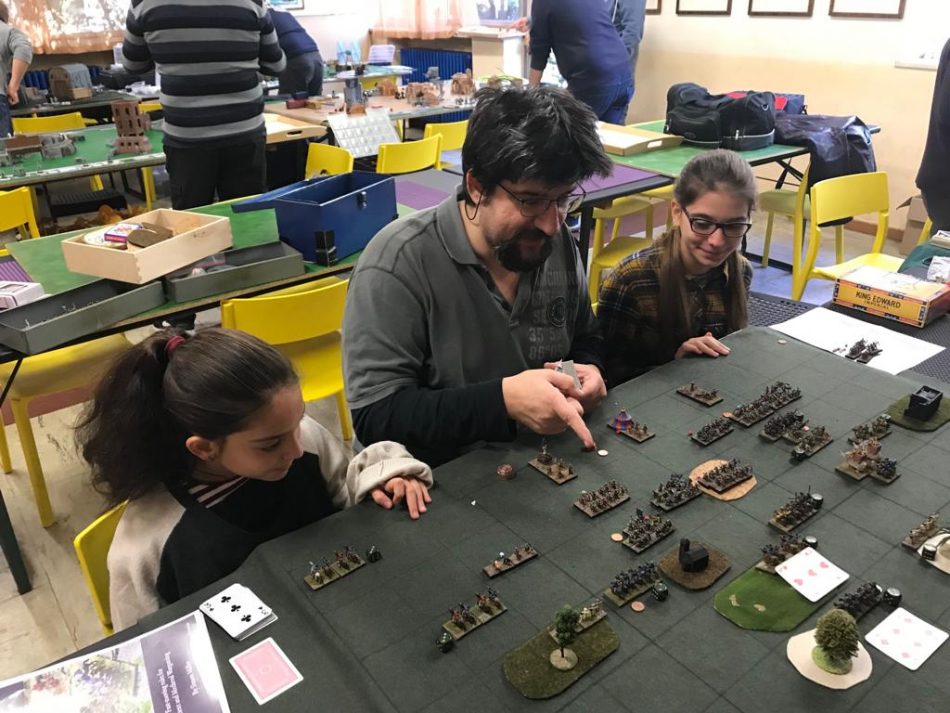To The Strongest, a board game with miniatures
We’ve recently seen how : a deep simulation for ancient/medieval warfare, with a manual written in a precise, . Now it’s time to go easier, with a fresh, modern set of rules you can read and understand without Britannica encyclopedia support, and be able to play at a decent level in a couple of hours – and we also had a chat with Simon Miller, the author behind the rules. Time to have a look at To
First the good news: you can play with everything you already have at home. At my club, full of DBx grognards, we are using for our TTS games the universal 4 cm-front bases with 15 mm miniatures, but I’ve seen friends playing TTS with 1/72 plastic soldiers or even with some cardboard with “KNIGHTS” written on the upper face. You and your opponent just need to agree on the scale, and you can play with really anything. TTS is played on an 8 x 10 checkboard, so the base dimension is not that important. With 15 mm, you can play on a mat that is half DBMM/FOW/Warhammer table.
We asked Author Simon Miller which scale is better in his mind:
Simon: “The best scale is that of the miniatures you already have. I mostly play in 28 mm, but others play in 15 mm, 10 mm and 8 mm. Some of my most enjoyable games have been played with painted wooden blocks. Twenty-eight mm is a great scale for display games at shows, but I can’t play it at home because I no longer have enough space. The smaller scales are much more practical; I’ve played 6mm in a bar”.
You don’t even need dice: instead of D10, you use two poker card packs. A weird choice? Hey, Simon, how comes the cards idea?
Simon: “Some people play with D10 – heretics, I call them. Others play with chits. There are a lot of benefits in playing with cards. A player at one end of a five-metre table can see the pair of Aces that an unlucky general has just played at the other end; that doesn’t happen with dice. Cards are quicker to play than dice are to roll, and are more exciting. But the most important thing, from a practical level, is that the cards sit behind the activated unit as a reminder of what its current activation number is”.

As in most wargames, the first step is to build the table: no armies ever fought in a totally open plain. You and your opponent select twelve elements each and place them on the table. The aim of the author is to be plain and simple: so, you will find only three kinds of elements.
The first one is the plain: you can have an open field or choose a gentle hill. The second kind is the “Difficult” terrain: woods, orchards, even dunes if you play an Arab or Egyptian army, or swamps if you fight with Venetians. In the Difficult, all close order troops suffer disadvantages. Finally, you have the Impassable terrain: it could be a small town or a deep crevasse. Over there, you can’t simply enter with any troops. So, you just need to remember these three terrains, really easy.
After having deployed the terrains, with the single rule you can place different types one near another, you check which one survives the card test. You place a single card near any terrain, and then you see the table in the manual: Clubs makes them disappear, Diamonds move them, and so on. The result is – generally speaking – a table with enough open spaces for infantry and cavalry, but some terrains on the wings. Sometimes you can be unlucky and find some Impassable in the center, so you need to split your legions or phalanxes, but this adds some taste and variety, and after a dozen of games we never found totally awkward or unplayable situations.
 On the left, you can see the terrains we placed in our test game, while on the right the elements still in place after the cards allocation: generally, only half of them stay on the table, so plenty of space to move, flank and fight.
On the left, you can see the terrains we placed in our test game, while on the right the elements still in place after the cards allocation: generally, only half of them stay on the table, so plenty of space to move, flank and fight.
The two players then deploy their armies, one command per side. The author has published () a “work in progress” version of the army lists for free, covering anything from ancient biblical period to the end of the Medieval era – same as DBMM, ADG, and FOG. Actually, in the lists themselves, you find full acknowledge for “inspiration” from older army lists of other rulesets, especially from DBMM ones. On the other hand, the same historic army lists will be similar even under different rulesets, since Romans or Carthaginians order of battles doesn’t change from one rule to the other!
Compared to DBMM, the typical 130 points TTS army list is normally half size in bases and miniatures. In any “square” of the checkerboard, you can place two units, and even the lowest quality army list can’t cover the full frontage with a double line. A full plate medieval army will cover less than half table, leaving plenty of space to enemy cavalry flanking maneuvers.
 Here you can see the armies just deployed. We had 100 Years War English facing a menacing Swiss army. Who will win: the Longbow or the Pike?
Here you can see the armies just deployed. We had 100 Years War English facing a menacing Swiss army. Who will win: the Longbow or the Pike?
In your turn you can give orders to one of your commands: you just choose which one you want to move first. When you move frontally or order your unit to attack it’s a “simple” move; if you go backward, turn front, slide laterally, it’s a “complex” move, and costs +1.
All is played with incremental cards. For example, you choose to move your Legio unit frontally you need to draw at least a “2”.
Let’s say you draw a “5”: you are happy and move the Legio. If you want to have a second “simple” move with that unit, you need to have the same value plus 1 (for the “simple” movement), so you need a “6”. If you’d want to slide on the right, you’d need a “7” (the “basic” 5 you already have drawn, +2 for the “difficult” maneuver).
If you are extremely lucky you can theoretically have six or seven moves with the same unit, but statistically, you can have two or three, so you need to gamble, and choose wisely the order you want to move the different units in the command. When you fail a movement card, you immediately stop and switch to the subsequent command – after the last Command fails, it’s time for the opponent bound.
 We use small wooden tokens for keeping track of the “heroes” (you can re-try a failed attack) and the lance for the knights. For bowmen ammunitions, we use small D6s.
We use small wooden tokens for keeping track of the “heroes” (you can re-try a failed attack) and the lance for the knights. For bowmen ammunitions, we use small D6s.
The Combat is even easier: there is no automatic combat in TTS. You need to order a troop to attack or to shoot, so you need to “activate” them like a normal movement. If you succeed, you draw another card: to hit in melee you need a “6”, in shooting an “8”.
If hit, the enemy needs to check the armour: each troop type has its own, so the skirmishers will save on 9 while the full plate knights will save at 5. The most significant difference between knights and light horses, or legions and hordes, is indeed the armour save.
The game also differentiate the troop types with other subtle differences: the Macedonian phalanx (or the Swiss pikes) will negate the enemy counterattack if they score a hit; the mighty Knights have a lance attack that doubles the chances to kill the charged enemies. The powerful English longbow shoots twice for each attack, while the light skirmishers can evade if charged. Nothing too difficult, but this achieves a wide variety of situations with army lists.
 The final stages of the battle: you can see the Swiss center has been shattered, with some English Bowmen on the right who got on their flank. The Swiss command on the left had perpetual movement problems, both for the difficult terrains in front of them and for bad card allocation.
The final stages of the battle: you can see the Swiss center has been shattered, with some English Bowmen on the right who got on their flank. The Swiss command on the left had perpetual movement problems, both for the difficult terrains in front of them and for bad card allocation.
When you play a 100 Years War English army, you will find it’s better to have bowmen and billmen one behind the other, to shoot the enemy and countercharge with the heavy infantry before the opponent successfully charges the weak bows in hand to hand combat. You can attack with Swiss pikes without caring about flank attacks since the pikes are frontally almost unstoppable, but you can’t with other close order infantries.
Also, some lists have specific rules: for example, Roman extraordinary training means you can do “difficult” maneuvers like sliding or retreating at the cost of simple ones – easy cake, Caesar!
The best way to describe TTS is “a board game with miniatures”. This game is plain and simple, with easy rules you can understand in a couple of games. I played a tournament with my eldest daughter (14 years old) playing the cards.
After two games, she was able to understand the “costs” of movements and the fighting phase. You can strategically outmaneuver your opponent: if you play Huns against Romans, you will be able to go on the flank of the Legio, but frontally you will be wiped out in few bounds.
So you have a strong “historic” feeling, without bothering for deep or abstruse rules. Obviously, the other side of the medal is, since TTS is “lighter” than DBMM or FOG, you will not have the same level of simulation offered by other deeper rulesets.
 We tested some other games with kids – in the photo, my daughters. Although they never enjoyed DBA (too complex), they really liked TTS games, and also wanted to play in the next tournament we had at our Milan club – the eldest won a game with her Greek army!
We tested some other games with kids – in the photo, my daughters. Although they never enjoyed DBA (too complex), they really liked TTS games, and also wanted to play in the next tournament we had at our Milan club – the eldest won a game with her Greek army!
We asked Simon about the design philosophy behind TTS:
Simon: “At first I wanted to make an extremely accessible game, that could be taught to children and non-wargamers in around 15 minutes – but once actual wargamers adopted it, I had to add more and more rules so it takes an hour now, as you say. But it is still a game that rewards expert players. At a recent competition, I (who like to think I know the rules pretty well) was mercilessly pummelled by three veteran players who know them far better, and who had given more thought to the composition of their armies and tactics. There’s plenty of depth for those who seek it- not that everyone wants to, or needs to.”
Length of a game? A TTS game will last under two hours. You just need to kill half opponent army, and when you destroy a unit, all friends close to him will have to do a test: again, it’s a simple rule you can learn easily with no “strange” situations, but it gives historical outcomes, with lines collapsing when the enemy knights create a gap. Simon is considering new periods for this rulest:
Simon: “I used to be a big fantasy wargamer (my BigRedBat “tag” derives from Greg Stafford’s world of Glorantha), and it’s likely that this will be the next big rules edition. That said, I am currently collecting miniatures for the Late c.17th, the War of the Spanish Succession and also the French army of 1814- there’s a definite whiff of gunpowder in the air, here!”.
Easy, but not oversimple: don’t underestimate TTS, since its mechanics work well and offer a wide range of situations a good player can exploit and use at his advantage. Ability and experience will make you choose the right order to attack the enemy, to disengage from the combat to recover from the “shaken” status, or to use a full bound to prepare your troops for a subsequent turn where you need to shoot or fight to deliver the final blow. A full wargame experience, without lots of headaches for sluggish rules and preparations, so why don’t give it a try at your club?
If you want more info on the game, just have a look at . You can buy there the rules (even in PDF for circa 10$, so you don’t need to wait a single minute to read and use them). They are well written and full of pictures and examples. Also, you can find the army lists – for now, they are still in “beta test” and free, and all the aids you need to play, like the mats and tokes.

Very nice report, I have it already translated in French, please can I publish it on French blogs and on my Facebook group to promote the rles?
Hi Robert
sure 🙂 just send us the link, we’re curious!
Paolo P.
Thanks Paolo! I will!
Hello Paolo I have a pdf version of the French translation, please let me an email adress so I can send it to you! Robert (auxiliapal@gmail.com)
Or if you can go here: https://www.facebook.com/download/270597577191560/article%20club%20italien%20TTS.pdf?hash=Acr1PNtRBcVp7C8w